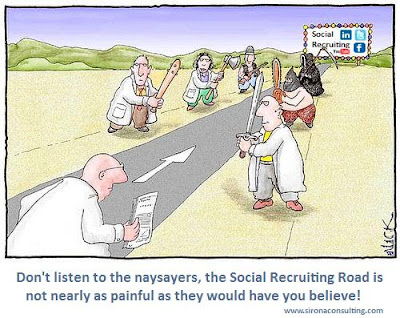
Source: The Sirona Says Blog
In an age where the competition for talents becomes red hot, the most important strategy that any organisation needs to have is to get the right people in, motivate, retain and develop them. With more and more Singaporeans spending a large amount of time online, it is critical that any HR recruitment strategy should examine how social networks and channels could be deployed in the fierce battle for talent.
In my view, there are two key ways to a social recruiting strategy: develop compelling organisational content, and leverage on the right channels and connections.
Compelling Organisational Content
Like any marketing or selling endeavour, getting quality candidates interested enough to join your organisation will depend not only on the official spiel of the company, but the stories that they heard. Word Of Mouth becomes very important in distinguishing between the choice employers from the more abysmal ones.
The most important factor is this: DIFFERENTIATE YOURSELF FROM THE REST.
In other words, whatever you put up should show
I have seen many recruitment advertisements that unfortunately showcase “heroic” employees doing glamourous tasks when the truth is often far more sordid and sombre.
How do you then show yourself to be different from the rest? Here are some possibilities:
1) Put up a video showcasing how staff have developed and grown as a result of what they do. If possible, keep this raw, authentic and amateur. We have seen so many slick and professionally done videos that having yet another one done just won’t do.
2) Get ready stories of staff who have excelled at their work or have specific anecdotes of how the job has added real meaning and value to their lives. Long-term staying colleagues may be good candidates to begin with, and they could perhaps share why they have sacrificed/ devoted such a large proportion of their time to the organisation.
3) Employ lots of photographs to tell the story, rather than merely text. If you can show staff doing things in the course of their work, that would be a plus point. Again, however, don’t over glamourise the shots!
4) Use humour and a light-hearted touch, and communicate in a direct and conversational manner (like normal human beings). In this day and age, nobody likes to work in an environment resembling a mortuary. In fact, even funeral parlours, hospitals and churches these days have remodelled themselves to be innovative and enterprising places to work in.
5) Develop content that is spreadable and easy to adapt. In other words, don’t just write a job description alone, but short little Facebook styled posts, blog posts, or 144 character (or less) microblogging posts (for Twitter or Plurk). Use photos and pictures.
6) Be creative and innovative but keep it real. Find the hidden ‘gems’ in your organisation who are able to stand out from the crowd and profile them. However, you need to be somewhat authentic. Working life isn’t a non-stop party where everybody dress up in clown suits with red alcohol-infused faces!
Comprehensive Channels and Correct Connections
The business of talent attraction is also defined these days by personal networks, Word Of Mouth and referrals. I find that in my own personal experience, some of my greatest hires came to me not through a conventional recruitment advertisement.
To leverage on the power of networks, here are some possibilities:
1) Get your employees to help to spread the word. This is probably the most pertinent and important point. Nobody is a better ambassador for the organisation than somebody who is already working there. However, do choose carefully who you enlist to help you spread the word.
2) Encourage them to use all of their personal social networking platforms – Facebook, Twitter, Blogs, Forums (if it is relevant to job employment), email lists and so on. Again, this is dependent on individual preferences as you cannot force them to do so – that would be antithetic to positive HR practices!
3) Leverage on your own organisational social platforms and networks. This could be the corporate website, Facebook fan page, Twitter, Blog, and so on. If you manage a forum, post it up there. For multi-organisational HQs, leverage on your subsidiaries and affiliate organisation’s own networks and request their help to spread the word.
4) Tap on professional networking sites like Linked-In, Plaxo, and professional interest forums to draw the right folks to your organisation. For example, if you’re looking for a curator or heritage specialist, wouldn’t it be good to look for people on heritage forums to begin with? Ditto for programmers, web designers, publicists, HR managers and so on.
5) Develop the tools for spreadability. This would mean tailoring the texts and descriptions in a way that makes it easy for people to just Forward/Retweet/Share the information to their networks. If necessary, you can even develop widgets that can be embedded on websites/blogs for this purpose.
6) Be personal in how you leverage on other people’s help. Don’t send a mass, nameless, faceless email blast asking all and sundry to help – the end result is that nobody will! Instead, look at customising and handcrafting each and every request for help to the individual (if possible), subject to limits of course.
7) As part of the 80/20 Pareto’s principle, don’t try to get every single employee or contacts help. It may perhaps be better to focus on those with the greatest influence (read: number of followers/friends/fans) as well as those with the right networks (ie people whom you are targeting as future employees).
